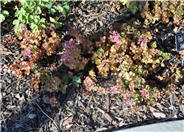
Common name:Dragons Blood Sedum
Botanical name:Sedum spurium 'Coccinium'
Dragons Blood is an old sedum variety, but it still shows up in nurseries, and for good cause. Foliage first emerges a bright red, and mellows to a lovely green with red margins during the summer months. Leaves become brilliantly red with cool autumn temperatures. Deep rosy-red flowers contrast with the green leaves in early summer. Use in rockgardens, along paths, at the edges of summer borders, or in parkstrips. Grows about 3 inches tall and spreads up to 24 inches wide.
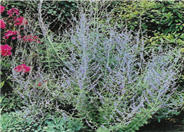
Common name:Blue Spire Russian Sage
Botanical name:Perovskia 'Blue Spire'
'Blue Spire' is a selection of perovskia that grows about 3 to 4 feet tall and 2 to 3 feet wide (though it will grow larger if over-watered). New wood is white and fuzzy; leaves are a soft green to grey-green and finely cut, giving it an airy appearance. Flower spires of fuzzy, lavender blue flowers begin in June and continue through the summer months. Useful in the perennial or shrub border, with ornamental grasses, and as a cut flower.
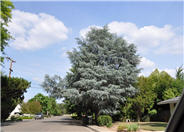
Common name:Blue Atlas Cedar
Botanical name:Cedrus atlantica 'Glauca'
As a large, slow-growing conifer, Blue Atlas Cedar requires ample room for growth. It has a broad, pyramidal form and is an eye-catching specimen for a large landscape. It's needles are 1 inch long, and are a beautiful shade of silvery blue. In order to develop its best color, the tree needs to be exposed to full sun. It can reach up to 40 to 60 feet tall and up to 30 feet wide. There is also a weeping form, Cedrus atlantica 'Glauca Pendula.' Cedars have lovely cones, emerging bluish when young and aging a reddish brown.

Common name:Eastern Redbud
Botanical name:Cercis canadensis
This small, deciduous tree with a rounded head is covered with small pea-shaped flowers of a rose pink to violet color in the spring before the appearance of large, heart-shaped leaves. It can grow to 25' tall with an equal spread. It has a low branching habit with a rounded form. During fall, foliage turns yellow. This is a great patio tree or for a small yard. "Forest Pansy" is a popular variety with spring leaves that emerge purplish and turn to a darker maroon.
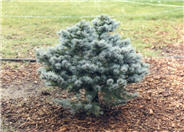
Common name:Dwarf Globe Blue Spruce
Botanical name:Picea pungens 'Globosa'
Globe-shaped evergreen shrub is is flat-topped, densely branched, and dwarf, making it a nice evergreen for small spaces or in a mixed border. Bright blue needles hold their color all year ut are brighter in summer. Full sun to light shade. Slow grower to 3 to 5 feet tall and 5 to 6 feet wide.
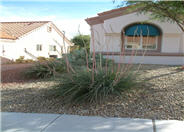
Common name:Red Yucca
Botanical name:Hesperaloe parviflora
This spectacular succulent grows to 3 to 4 feet tall and wide. Blue green leaves are strap-like, leathery, long, with white fraying fibers on the edges. During the summer, dark pink flowers are seen on arching, red stalks, and reach up to 6 feet. Hummingbirds love these flowers. This evergreen plant is drought tolerant once it's established but will appreciate extra water during the summer to promote blooms. Plant in full sun or light shade, with well draining soil. Deer like the foliage.
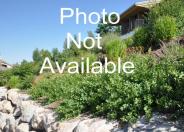
Common name:Hummingbird Trumpet; Fire Chalice
Botanical name:Zauschneria latifolia
Eye-catching as red lipstick, little red-orange trumpets stand out from leafy stems, creating a lovely sphere of color that lasts from mid-summer to frost. Native to droughty, rocky places at higher elevations, it also makes its home along waterways, indicating that a little additional water will be appreciated and used to extend the flowering season. Fire Chalice will form a slightly woody perennial base then die back to the ground with the coming of the first hard frosts. Grows 12 to 18 inches tall and about 24 to 36 inches wide.
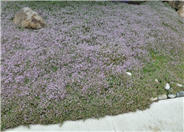
Common name:Reiter Creeping Thyme
Botanical name:Thymus 'Victor Reiter'
Reiter thyme is a tough, vigorous groundcover. Forms dense mats that can tolerate foot traffic and choke out most weeds. It grows to 3 inches tall and spreads 30 inches. Rich, olive green foliage is topped with lavender flowers in mid-summer. Faded flowers can be removed using a lawn mower. It has a pleasant, minty fragrance when crushed, though not considered for culinary uses. Attracts bees and butterflies.
| Designer: Xeriscape Design | Color Hill 5 |
Photographer: GardenSoft |
Water Saving Tip:
Even though it's hot, your lawn only needs to be watered twice a week to stay healthy.
And don't water the whole lawn for a brown spot—drag out a hose.
